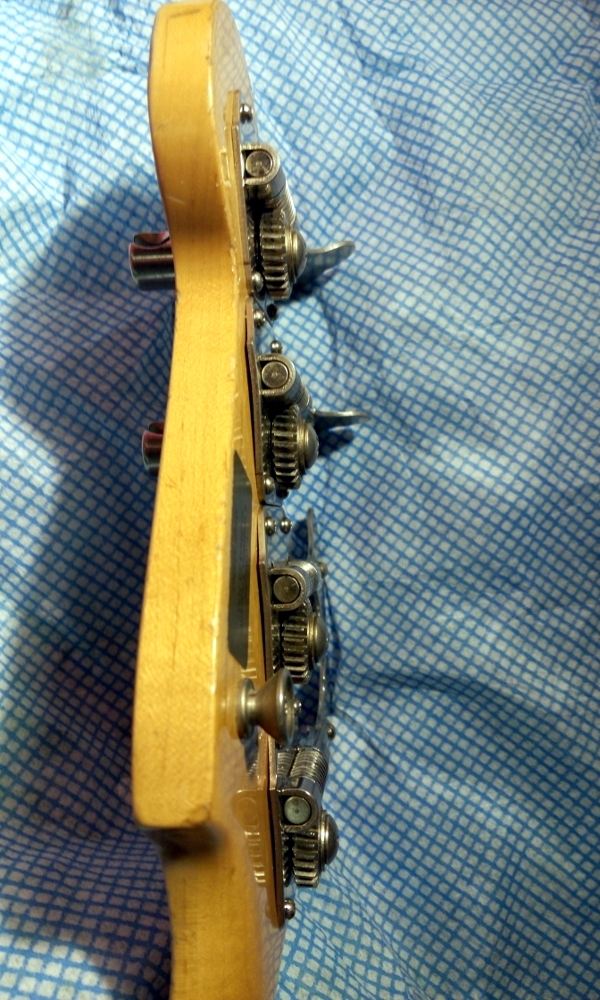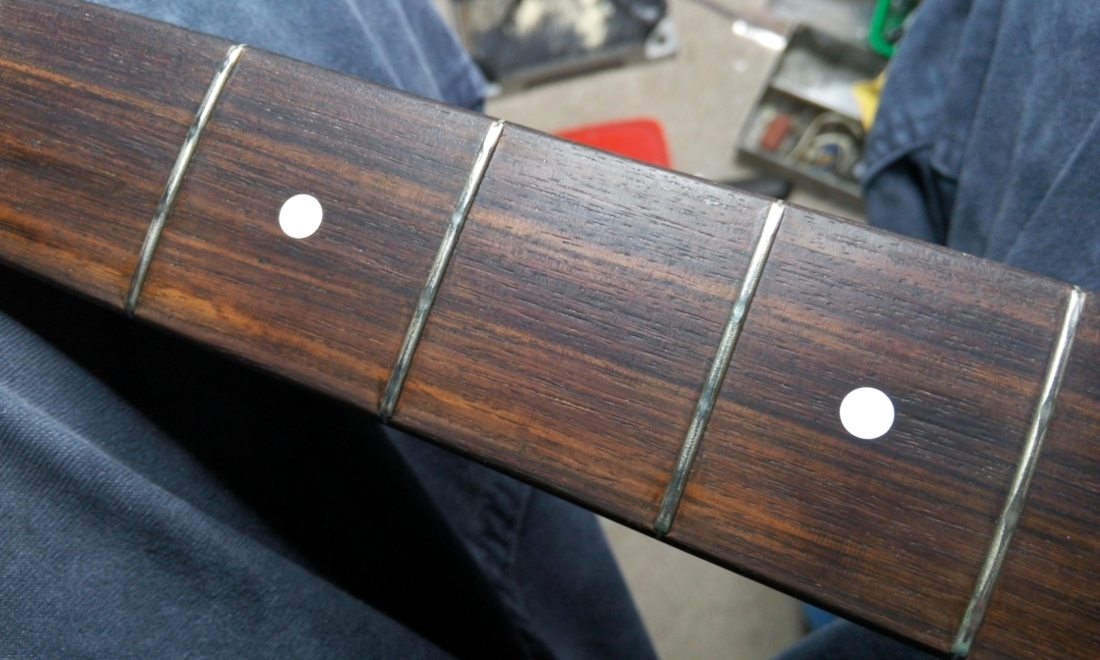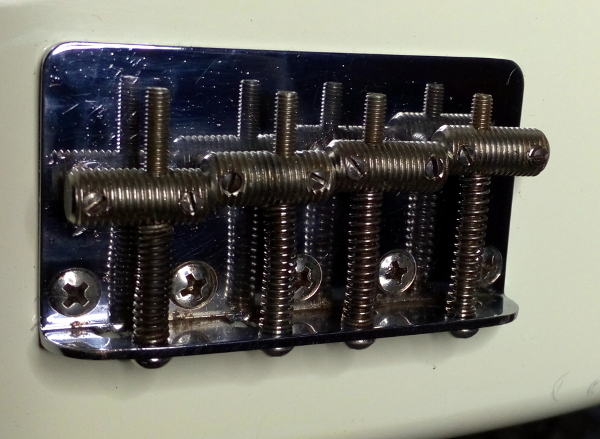Precision Bass Repair Log
Repair Log – April 1983 Squier Vintage Precision Bass SN:JVXXXXX made in Japan
15/06/17 Copyright reserved Terry Relph-Knight
Current value – £500 to £600
Delivered with a very worn gig bag.
One of the excellent Fender Japan Squier Precision Basses made in the FujiGen Gakki factory, this instrument has been gigged hard for all its life and this is the first time it has ever been serviced. The only user modification made to it is the replacement of the original tortoiseshell pick guard with a white 3 ply guard.
With the exception of another new cream pick guard the owner wanted to keep this bass as original as possible, so all the old hardware was removed, re-furbished and then re-fitted to the bass.
A U shaped route in the body below the truss rod nut was revealed when the white pick guard was removed. This is a very useful feature because it allows easy adjustment of the truss rod without any disassembly of the bass. A matching cut out was made in the new cream pick guard to allow easy access to this feature.
Body – Four piece body, possibly Japanese Sen (Ash) in Arctic white finish, with a 3 ply white pickguard (Owner tells me this replaced the original tortoiseshell guard). White self adhesive neck shim at the bottom of the neck pocket printed Fender 83 4. The body is in reasonable shape but it does have numerous scratches and dings. The largest is through to the wood on the edge above the forearm contour. Three standard conical strap buttons, (two fitted with rubber strap stops) one below the bridge, one on the upper horn and one on the back of the headstock. Body has a U route in the bottom edge of the neck pocket for easy access to the truss rod adjustment.
Neck – 12 inch radius C profile one piece maple neck with a slab rosewood fret board. 20 small vintage frets, white dot markers. Date 4 13 ‘83 hand written on the end of the neck. A stamp – 5 . EX T on the back of the neck heel. An L shaped brown wear mark on the headstock shoulder below the E tuner, possibly from a hanger. Four bolt, chrome plated, thin steel neck plate, with the serial number stamped on it. The four neck ‘bolts’ are (very rusty) cross head. They are the older tapered style with a smooth shank above the threaded portion.
Truss rod adjusted by a cross head barrel nut at the heel. Tightened by about one half turn as received.
Fairly heavy fret wear down to the 9th fret.
A small gold label reading – C D Music, 6 Westwick Crescent, Sheffield S8 7DG (0742) 377967 is stuck on the back of the headstock. Another one of these labels is stuck to the middle underside of the scratchplate.
Repair Log Squier Vintage Precision
Hardware – 4 riveted clover leaf, nickel plated tuners with Kluson style hole and slot string posts. All four tuner base plates are bent upwards in the middle by around 1mm. Tuner posts, the worm and all tuner parts, apart from the round brass gear, are made from steel. One old style circular string tree. One split humbucker PB pickup, covers are quite worn, height screws are rusty and support rubber may need replacing. Volume and tone controls with knurled flat top aluminium knobs, originally chrome plated (most of the chrome has worn off).
Volume control is 286.4K Tone is 279.9K both 20% curve. Tone cap is 104 (0.1uF) plastic film with green resin dip.
Top loading Fender bridge (really filthy) – chrome plated, bent, 1.5mm steel base plate, attached to the body with five chromed cross head screws (it was rust city under the bridge plate). Four 5/16 diameter, threaded, nickel plated brass, saddles with slotted head height adjustment screws at either end. Each saddle with a 1.5inch cross head intonation screw and spring. All bridge screws are nickel plated steel.
Strung with Thomastik-Infeld JF344 Jazz Flatwound 34inch long scale 4-String Bass Guitar Strings, 43, 56, 70, 100 Long Scale at £54.99 from Strings Direct (actually paid £45.73 from Thomann).
Action – clearance at the first fret with string depressed at the second is zero. Open string height at the 12th is 2.5mm on the E and 1.75mm on the G. Maybe 0.5mm relief. Open string pickup clearance is 5mm on the E and G. The two halves of the pickup are tilted to follow the fretboard radius.
Intonation as received
Distance between back of saddle and front of bridge fold
E+419.5mm
A 0 19.0mm
D +2 22.0mm
G +4 22.0mm
After re-furbishment and with new Thomastik strings, intonation at the 12th fret was adjusted to zero error.
Fender set-up guide
PICKUPS
Bass SideTreble Side
Vintage style 8/64″ (3.6 mm) 6/64″ (2.4 mm)
Noiseless™ Series 8/64″ (3.6 mm) 6/64″ (2.4 mm)
Standard “J” or “P” 7/64″ (2.8 mm) 5/64″ (2 mm)
Special Design Humbuckers 7/64″ (2.8 mm) 5/64″ (2 mm)
ACTION
Neck Radius String Height Bass Side Treble Side
7.25″ 7/64″ (2.8 mm) 6/64″ (2.4 mm)
9.5″ to 12″ 6/64″ (2.4 mm) 5/64″ (2 mm)
15″ to 17″ 6/64″ (2.4 mm) 5/64″ (2 mm)
Adjusted this bas to 1.75mm 1.75mm
Possible new parts
Wilkinson bass bridge – £11.99 plus post (with grooved brass saddles) from Northwest Guitars
(Fender Vintage bass bridge – £53!!!)
Pair of knurled knobs – £4.33
13 pickguard screws – £1.52
4 stainless steel necks screws – £1.60
Thomastik JF344 are £54.99 inc post for Strings Direct or £48.08 via Amazon inc post, or even £46.51 Thomann.
An aside – Rogers Waters apparently uses Rotosound ’77 Jazz Flat strings. These are diagonally flat wound with Monel alloy tape.
Work done – Bridge removed, disassembled, cleaned and reassembled (including the saddle with the jammed screw – now replaced) with all four saddles reversed so that the old worn string grooves are underneath and the unused side is now upwards. Rusty patch on the body under the bridge polished smooth and clean. Neck removed and dirt (literally!) scraped from fretboard, fretboard smoothed, cleaned and polished with a little beeswax. Truss rod nut removed, thread lubricated and replaced.
Tuners / machine heads removed, polished and lubricated. Volume and tone pots sprayed with DeOxit.
Knobs removed, cleaned and polished.
Original fitting of the machine heads was incorrect and the baseplate’s were bent. The bearing hoops that hold each end of the worm gear are attached to the base plates by folded tabs. These pass through the plate and are bent over to hold the hoops in place. These tabs protrude below the base plates by about 1.5mm. Unless small routes are made in the back of the headstock to allow clearance for these tabs, the base plates of the tuners will not sit flat on the headstock. Clearance routes had not been cut in this headstock and as a result, when the four corner attachment screws on each base plate were tightened, the base plates bent so their centres stood proud from the back of the head stock. I marked and drilled the tab positions, re-bent the plates so they were flat and then re-mounted each tuner.
Pickup removed, magnet poles cleaned, very scratched dual pickup covers sanded smooth, old rubber support pads on brass dogleg carrier replaced with new and the brass polished to remove corrosion. Pickup output wires replaced with a short length of screened cable. Pickup securing screws replaced.
All electronics wiring replaced with silver plated wire with PTFE insulation. All electronics cavities in the body of the bass lined with grounded self-adhesive copper tape, shielding against electrical interference.
Output jack socket cleaned, polished, re-tensioned and coated with DeOxit (the inside of the jack ferrule had a lot of green corrosion in it).
Control pots sprayed with DeOxit contact cleaner.
Frets with high ‘sprung’ ends treated with superglue. Neck adjusted to ‘flat’ using the truss rod and the Technofret leveling beam and three spacers. Frets then milled flat and all wear dents removed using the Technofret sanding beams. Frets re-crowned with a crowning file, then polished using the Crimson Guitars set of abrasive blocks.
New cream (Ivory) pick guard fitted and trimmed to fit the neck pocket. U shaped slot cut to allow access to the truss rod. Truss rod U route in the body trimmed smooth and coloured black.
Bass strung with Thomastik Infeld 344 Jazz flatwound strings. Action and intonation adjusted with the new strings.
Neck pocket shimmed with copper tape on the lower left side and in the right corner, so that under string tension the neck will now naturally sit in the pocket so that there is equal spacing from the E and the G strings to the edge of the fretboard.
Diagnostics –
Looking at the back of the headstock you can see all four of the tuner base plates are bent upwards.
Owner says he has some fret buzz on the E at the 5th and 13th frets.
Looking just at the E string under loose tension there are two very clear permanent bends in the string above the bridge and just below the fretboard (the two positions where the string is plucked most). It is likely that these bends alone are contributing to the fret buzz.
Looking at the frets there is a lot of wear up to around the 9th fret, certainly the buzz at the 5th could be all down to fret wear, but by the time the 12th and 13th frets are reached there is a lot less wear. However checking with a fret rocker tool I can feel some high fret ends on the E side. Under magnification I can see they have lifted a little. I have tried tapping them down with a fret hammer but they still spring high. You can see them moving (11, 14, 15 & 16) because when struck with the hammer the dirt trapped under the fret is squeezed out. Fret 7 was low.
Pickups
This bass has the standard P Bass two coil split humbucker pickup. Each coil has Forbon fibre end cheeks, friction fitted onto four 3/16 inch diameter Alnico 5 rod magnets. The coils are not wax potted.
Rectangular plastic covers, with height adjusting mounting screws at either end, are a loose fit over the coils. Each coil is held in place in the cover by the pressure of a section of dense black rubber foam under the coil ‘bobbin’ which also provides the upward force against the mounting screws.
A dogleg brass plate is dropped in to the bottom of the pickup route in the body and the two strips of rubber foam are stuck to this plate. The plate is also part of the ground return to the controls – a wire from one coil end is soldered to the plate and a wire soldered to the plate goes to the control ground.
E – A coil
L in HenrysQR in K
120Hz 2.76 0.4270 4.991
1000Hz 2.763 3.272 5.313
D – G coil
L in HenrysQR in K
120Hz 2.757 0.4198 5.069
1000Hz 2.762 3.211 5.411
Both coils in series connected finish-start to start-finish
L in HenrysQR in K
120Hz 5.616 0.4304 10.07
1000Hz 5.611 3.269 10.80
Parts
13 pickguard screws – £1.50
4 stainless steel neck screws – £1.60
4 pickup screws – £2.80
New rubber pads for the pickup – £ 1.00
New pickguard – £20.50 inc post
Thomastik JF344 strings – £45.73
Parts total – £73.17




